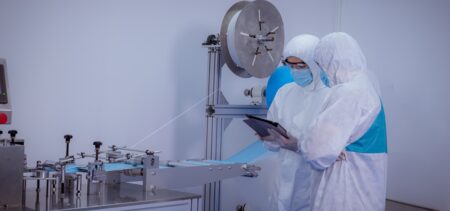Elon Musk. Jeff Bezos. Bill Gates. These three men have a lot in common. They’re all tech founders who have disrupted their respective industries and cemented their place in the annals of history for their global (and extra-terrestrial) dominance. Between them, they have a combined net worth of just over half a trillion US dollars. They’re using their vast experience, considerable resources, and entrepreneurial spirit to explore a new frontier: the human brain. With Elon heading up Neuralink and Bezos and Gates teaming up at Synchron, the race is on to develop a chip that integrates neural pathways to computers in an effort to give people with reduced mobility, and disabilities, new hope.
Here’s how the two companies are making headway:
Neuralink: A Brief Overview
Neuralink’s mission is to “Create a generalized brain interface to restore autonomy to those with unmet medical needs today and unlock human potential tomorrow.” They achieve this through a brain chip interface (BCI) which receives, records, and decodes neural signals and then transmits information back to the brain.
Referred to as the “Link,” the implant is a small, coin-sized chip that is surgically placed under the skull. Neural threads cover the sections of the brain that are responsible for motor control, and these threads send the signals to the Link. Individual wires have sensors that generate and transmit electric currents. According to Neuralink, the sensors are built by an in-house neurosurgical robot.
The idea for Neuralink is that with an app (currently in the development stage), users will be able to control a mouse and keyboard using their minds. Sumner Norman, a scientist at Convergent Group and former Chief Brain-Computer Interface scientist at AE Studio, said, “Neuralink is really at the vanguard of creating the commercialized, scalable versions of what has been pioneered in academia. There’s been decades of academic research to push this as far as it can go, but ultimately it becomes a very expensive space to develop.”
With the exorbitant costs of research and development, it’s no small wonder why only the wealthiest people on the planet are vying to be the first to break ground in this space. Thus far, Neuralink has raised a total of 680 million dollars over five rounds of fundraising, and it has paid off, with the company receiving a valuation of $5 billion.
How It Works
Brain activity and bodily function work through electrochemicals in the brain. Neurons carry these “sparks” of electricity and pass the message along via synapses. Our brain has sensors that then capture these sparks and can detect voltages and thereby measure changes in voltage from these sparks. Essentially, brain activity data is recorded when we take an action, but also when we think about taking an action. This is how Neuralink’s brain-computer interface works.
Neuralink simulates the electric chemical signals that enable communication in the nervous system. The brain-computer interface measures brain activity and decodes the signals according to their actions. According to Sonal Baberwal, a Dublin City University researcher working on machine learning algorithms, “It simply measures the brain activity and interprets it as an action. Similarly, with your brain signals—eyes closed or opened, a relaxed or deep-sleep state, an action or focus state—all of these aspects can be detected.” According to Barberwal, the Neuralink chip is similar to how blood pressure readings indicate a patient’s state of relaxation or stress.
Benefits of Neuralink
Neuralink aims to assist people with immobility issues to regain lost skills like communication. With further research and development, they hope to restore motor, sensory, and visual function and treat neurological disorders. Neurable’s CEO, Ramses Alcaide, said, “A Neuralink-like device has the potential to enhance human memory, processing speed, and cognitive abilities by creating a direct interface between the human brain and digital devices.” There are a number of outstanding benefits which include:
Restoring Mobility
Brain-computer interface enables users to control prosthetics or exoskeleton suits. For people living with paralysis or facing limb amputations, Neuralink is a chance to regain a degree of mobility and live life independently.
Improve Communication For Non-Verbal Individuals
Currently, Neuralink’s main aim is to help non-verbal people regain communication skills through control of a virtual keyboard and/or mouse, allowing them to create thought-controlled messages. In the long run, the hope is that a person with paraplegia would be able to use thought-control methods to navigate the internet or even create art by using “thought-to-speech” or text synthesis.
Treat Neurological Conditions
Neuralink has the capacity to monitor brain activity in real time. This means changes picked up by the brain-computer interface can provide useful data in understanding neurological conditions like bipolar disorder, obsessive-compulsive disorder, and epilepsy. There’s also renewed hope for patients with incurable degenerative diseases like Parkinson’s and Alzheimer’s.
These neuro-chips can be used to not only monitor the symptoms of mental health but could potentially provide targeted treatment in the form of electrical stimulation to affected parts of the brain. This is great news for people with chronic issues like burnout, anxiety, depression, and fatigue. This is possible because chronic mental illnesses are contained in one part of the brain, unlike motor skills, which require different parts of the brain to stimulate function.
“Treating or curing paralysis, neurological disorders, and injuries could make the world a substantially nicer place, where very few people have untreatable forms of depression or anxiety,” said Norman, an expert developing brain-computer interfaces and neuroprosthetics for people with neurological injury or disease. “Giving agency back to those who’ve lost it—that’s an undeniable benefit.”
Enhance Cognitive Abilities
According to Elon Musk, the brain-computer interface is similar to a “Fitbit in your skull”.
“If suddenly you could get every neuron in the human brain and sense them all at once, what would you actually do with that data?” Experts, admittedly, cannot answer the question. “We don’t know,” Norman said. “There are 80 billion neurons in the brain with about 1,000 synapses in between them—how do you interpret that kind of data?” Norman went on to speculate that Neuraink is able to detect 10,000 neural connections, a vast improvement on the few hundred academics are currently able to study.
Synchron
Based in New York, Synchron, a direct competitor to Neuralink, is backed by both Jeff Bezos and Bill Gates. Ahead of Neuralink, Synchron has already entered its trial phase and is closer to realizing the goal of becoming the first company to provide patients with endovascular therapy that’s administered through an implantable device.
The feasibility study is aimed at assessing the safety of the device and its implantation into the brain’s blood vessels. Additionally, they’ll be looking at the Synchron Switch, the brain chip device that enables neuroprosthesis (the ability to gain control of the parts of the brain responsible for motor control) in paralyzed patients.
Similar to Neuralink, the Synchron Switch is designed to detect and transmit brain signals, enabling patients to regain the use of devices. It’s implanted via the jugular vein and sits in the blood vessel found on the brain’s motor cortex. Once in use, patients will be able to make use of computers and other devices using thought processes. This improves independence through their ability to text, send emails, shop online, and access healthcare through telehealth services.
In a show of widespread approval, the trial has received support from the National Institute of Health’s BRAIN initiative. Synchron received a ten million dollar grant from the institution to kickstart the trial, which will be conducted at three sites, Mount Sinai Health System, the University at Buffalo Neurosurgery, and the University of Pittsburgh Medical Center which is collaborating with Carnegie Mellon University of College Engineering.
Synchron has already made results from its first study available. Four severely paralyzed patients received their first-generation Stentrode implant. The study was led by a team of doctors from the Royal Melbourne Hospital and the University of Melbourne, which proved the device is able to safely transmit neural signals without producing adverse effects from implantation or long-term use.
Patients were observed over 12 months and in the final follow-up showed no persistent neurological deficits, signs of clotting, or device migration. Participants were able to effectively use the implant to text, send emails, bank online and communicate care needs. The study results can be found in JAMA Neurology.
Conclusion
Amazon, Twitter, Microsoft, SpaceX, Tesla, BlueOrigins. These are just a few of the companies Jeff Bezos, Elon Musk, and Bill Gates have founded, acquired, and led. They’ve disrupted tech, telecommunications, e-commerce, agriculture, energy, the automotive industry, space exploration, payments, AI, and more. With over half a trillion US dollars between them, they have the resources and capacity to tackle a critical issue, neurotech, and the possibilities it offers to disabled and mobility-impaired people.
With the race to go to market between Musk’s Neuralink, and Gates and Bezos’ joint operation in Synchron, there are endless opportunities on the horizon for the patients that will benefit from the neurotechnological advancements.
While we wait to see the latest developments and research that will come out of Synchron’s trials, with Neuralink in hot pursuit of the same, there is much to be excited for in the coming few years. Watch this space!































